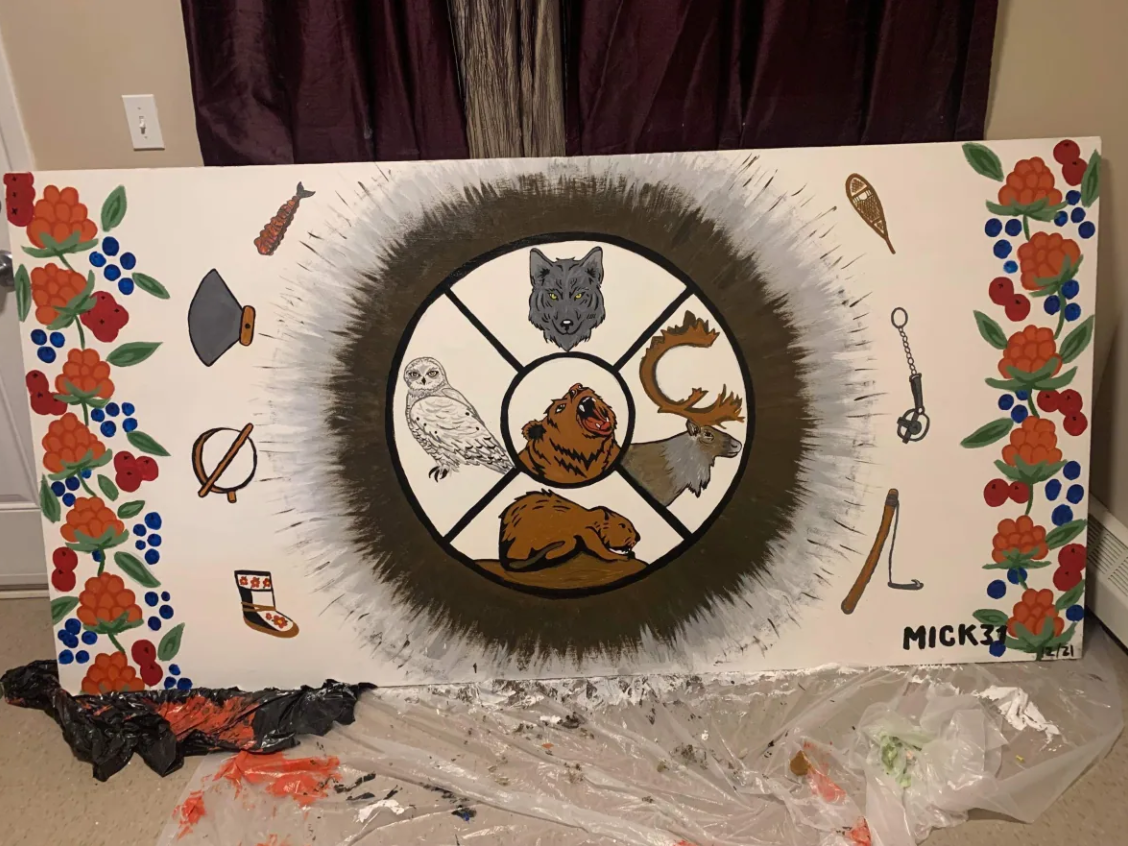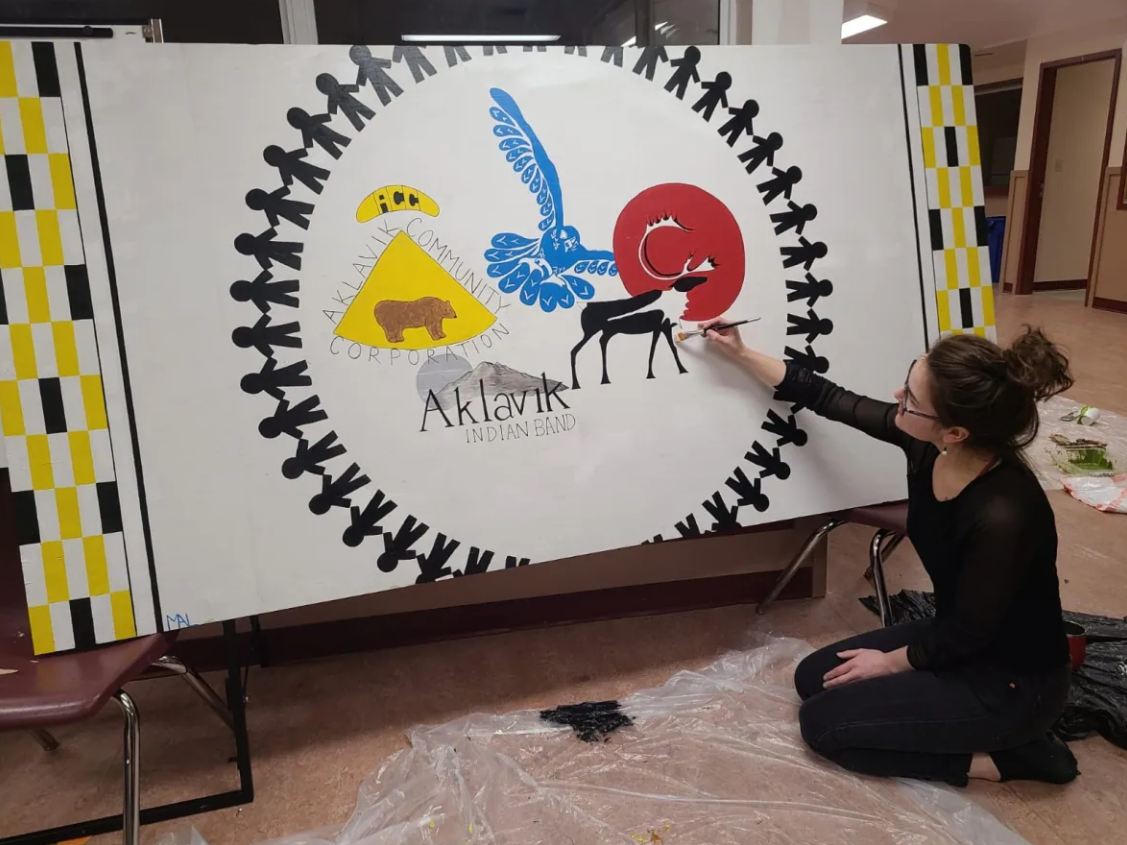33 new Inuvialuit murals to be displayed in communities across Canada’s Northwest Territories
Rcinet.ca | December 20, 2021
Categories: news
Six N.W.T. communities are about to get more colourful.
Thirty-three murals have been commissioned by the Inuvialuit Regional Corporation (IRC) as part of the Inuvialuit Mural Project. It aims to reinforce community pride and establish greater connections between Inuvialuit of all ages, said Brian Wade, director of Inuvialuit Community Economic Development Organization.
Wade said the project’s other aim is to prepare for the return of tourism to the region in the future by having highly visible expressions of Inuvialuit culture to display, while supporting local artists.
The IRC provided materials and supplies to six communities: Aklavik, Inuvik, Paulatuk, Sachs Harbour, Tuktoyaktuk and Ulukhaktok. The organization reached out to Inuvialuit and not-for-profit groups to participate in the creation of a local art project, said Wade.
He added that the artists and mentors were paid for their work and that the murals will be displayed in their home communities. He also said high resolution photos will be taken so the paintings can be replicated to be displayed on Main Street in Inuvik.
‘What makes Aklavik Aklavik’
Aklavik artists are among the first to complete their murals.
Courtney Charlie, of Aklavik, is one of these artists.
She said she put her name forward for the project because she loves to paint and liked the idea of representing the Aklavik she knows for everyone to see.

“I thought a lot about what makes Aklavik Aklavik,” said Charlie.
Resiliency of her community was a theme offered by organizers to inspire murals, she said.
She said she wanted to depict, “the strength we have as a community as a whole and that culture is slowly coming back after residential schools.”
Her painting depicts a figure in a traditional parka with a drum, and a mountain and sun behind them, surrounded by animal imagery.
Creating the painting had Charlie thinking about places she goes with her family, like the Richardson Mountains. She also thought about traditional activities she does, like picking berries, that connect her to her culture, she said.
‘Never say die’
Many students at Aklavik High School collaborated on another mural.
Heather Evans, a teacher at the school, said there is no art studio at the small school, so the back half of her classroom was transformed into an art studio for three weeks while the mural was being painted.

Jodi Arey was the lead artist. Colton Archie, Sarah Meyook, Deadra Greenland, Starr Elanik and teachers Heather Evans and Amanda Reynolds also worked on the project.
“You really see a different side of your students when you give them hands on activities,” said Evans. “The vision started with Jodie, but then morphed into a representation of everyone together.”
The project really connects the community and creates a sense of belonging, which is something Arey has also spoken about, said Evans.
The mural depicts a caribou and seasonally changing backgrounds with activities people would do in the community in each season, said Evans.
The painting has the Aklavik motto, “Never say die”, written in Inuvialuit and Gwichʼin, because it was important to the students to reflect both cultures represented in Aklavik and the school, said Evans.
‘It was therapeutic’
Miranda Kowana also wanted to reflect both cultures in her work, but she did it primarily through animal imagery.
The owl in her painting represents Inuvialuit and the caribou represents Gwichʼin, she said.
Reflecting togetherness was important to her in the work.
Kowana also wanted to reflect the importance of trapping in her mural, including related symbols and several of the animals found in the area. She is now considering doing a second painting in the future on related themes.

Usually Kowana is more of a drawer, although this is her second painted mural for her community. She recommends others “just do it” if given an opportunity like this in the future.
“It was therapeutic,” said Kowana of painting the piece.
She lives in Aklavik, but initially applied while in isolation in Inuvik. When she returned home and was accepted to the project, she painted when she could carve out some time between working at the local general store, Stanton’s Grocery Store and caring for her young son.
She said conversations with her friend Erica Omilgoituk helped inspire the design.
Reflecting a new home
For Megan Lennie, making her painting was about reflecting her newer home.
Lennie is from Inuvik, but moved to Aklavik in adulthood after attending art school at the Emily Carr University of Art and Design.
This is her largest piece to date, she said. It incorporates the Aklavik braid.
Uniting the two Indigenous groups, Inuvialuit and Gwichʼin, in the painting by having the braid and silhouettes of people surround both logos was important to her design, she said.

Other artists across the Inuvialuit region continue to work on their murals. The IRC is excited about the long term effects the project will have on promoting Inuvialuit culture, supporting local artists and drawing visitors to the region, said Wade.
Read the article on rcinet.ca.


